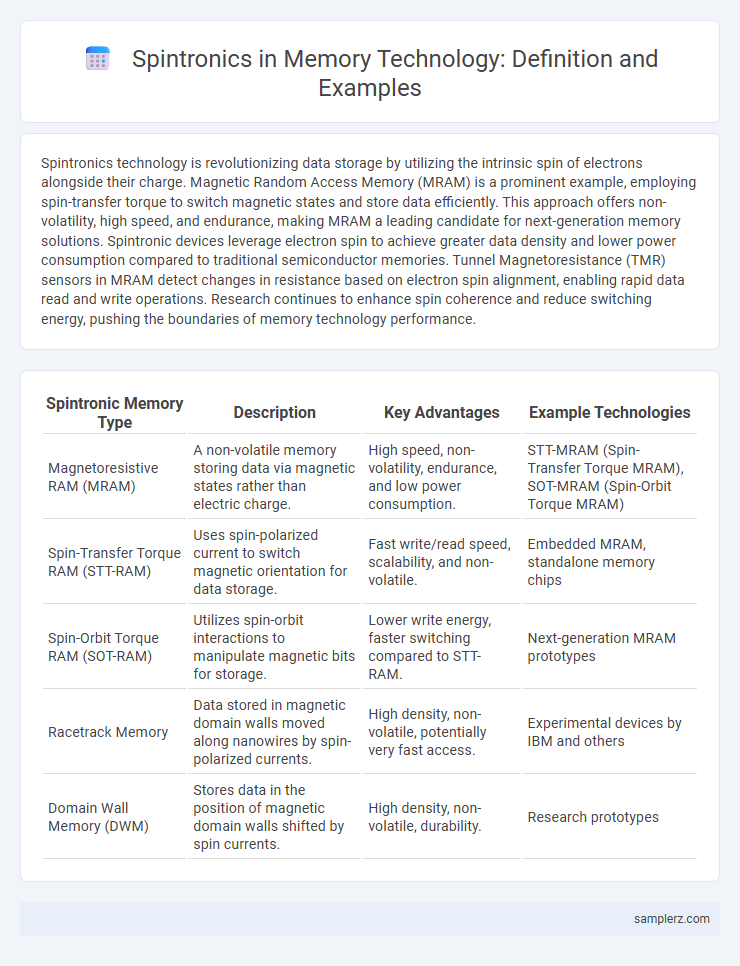Spintronics technology is revolutionizing data storage by utilizing the intrinsic spin of electrons alongside their charge. Magnetic Random Access Memory (MRAM) is a prominent example, employing spin-transfer torque to switch magnetic states and store data efficiently. This approach offers non-volatility, high speed, and endurance, making MRAM a leading candidate for next-generation memory solutions. Spintronic devices leverage electron spin to achieve greater data density and lower power consumption compared to traditional semiconductor memories. Tunnel Magnetoresistance (TMR) sensors in MRAM detect changes in resistance based on electron spin alignment, enabling rapid data read and write operations. Research continues to enhance spin coherence and reduce switching energy, pushing the boundaries of memory technology performance.
Table of Comparison
| Spintronic Memory Type | Description | Key Advantages | Example Technologies |
|---|---|---|---|
| Magnetoresistive RAM (MRAM) | A non-volatile memory storing data via magnetic states rather than electric charge. | High speed, non-volatility, endurance, and low power consumption. | STT-MRAM (Spin-Transfer Torque MRAM), SOT-MRAM (Spin-Orbit Torque MRAM) |
| Spin-Transfer Torque RAM (STT-RAM) | Uses spin-polarized current to switch magnetic orientation for data storage. | Fast write/read speed, scalability, and non-volatile. | Embedded MRAM, standalone memory chips |
| Spin-Orbit Torque RAM (SOT-RAM) | Utilizes spin-orbit interactions to manipulate magnetic bits for storage. | Lower write energy, faster switching compared to STT-RAM. | Next-generation MRAM prototypes |
| Racetrack Memory | Data stored in magnetic domain walls moved along nanowires by spin-polarized currents. | High density, non-volatile, potentially very fast access. | Experimental devices by IBM and others |
| Domain Wall Memory (DWM) | Stores data in the position of magnetic domain walls shifted by spin currents. | High density, non-volatile, durability. | Research prototypes |
Introduction to Spintronics in Memory Devices
Spintronics in memory devices leverages electron spin alongside charge to enhance data storage efficiency and speed. Magnetoresistive Random Access Memory (MRAM) showcases this technology by using magnetic tunnel junctions to store bits, offering non-volatile memory with high endurance and low power consumption. These innovations mark significant advances in memory technology, enabling faster access times and improved energy efficiency compared to traditional semiconductor memories.
Evolution of Memory Technologies: Enter Spintronics
Spintronics has revolutionized memory technologies by enabling non-volatile memory with faster read/write speeds and lower power consumption. Magnetic Tunnel Junctions (MTJs) serve as the fundamental units in Spin-Transfer Torque Magnetic Random Access Memory (STT-MRAM), offering high endurance and scalability. This evolution from traditional DRAM and Flash memories enhances data retention and paves the way for next-generation computing performance.
Magnetic Tunnel Junctions (MTJ) in Data Storage
Magnetic Tunnel Junctions (MTJ) serve as the cornerstone of spintronic memory devices, utilizing electron spin to achieve non-volatile data storage with high speed and low power consumption. These MTJs consist of two ferromagnetic layers separated by an insulating tunnel barrier, where the relative alignment of magnetizations encodes binary information. MTJ-based Magnetoresistive Random Access Memory (MRAM) exemplifies the integration of spintronics in data storage, offering enhanced endurance and scalability compared to conventional semiconductor memories.
Spin-Transfer Torque Magnetic RAM (STT-MRAM) Applications
Spin-Transfer Torque Magnetic RAM (STT-MRAM) leverages spintronics to enhance memory performance through non-volatile storage and fast read/write speeds. Its applications include high-density cache memory in microprocessors, embedded memory in mobile devices, and storage-class memory for data centers. The technology's low power consumption and high endurance make it ideal for next-generation computing systems requiring reliable and efficient memory solutions.
Spin-Orbit Torque RAM (SOT-RAM): Next-Gen Memory
Spin-Orbit Torque RAM (SOT-RAM) leverages the spin-orbit interaction to enable faster and energy-efficient data writing compared to traditional MRAM technologies. By utilizing spin currents generated through heavy metal layers, SOT-RAM achieves low-power, high-speed switching, making it a promising candidate for next-generation non-volatile memory applications. Its endurance and scalability address the limitations of conventional flash memory, positioning SOT-RAM as a key technology for advanced computing systems.
Domain Wall Memory: Racetrack Paradigm
Domain Wall Memory (DWM), based on the Racetrack paradigm, utilizes spintronics to store data by manipulating magnetic domain walls within nanowires. This emerging technology offers non-volatile, high-density storage with faster read/write speeds and greater endurance compared to traditional flash memory. The use of current-induced spin-transfer torque enables efficient domain wall movement, enhancing memory reliability and energy efficiency in advanced computing systems.
Non-Volatile Spintronics Memory Solutions
Non-volatile spintronics memory solutions, such as Magnetic Tunnel Junction (MTJ) based MRAM (Magnetoresistive Random Access Memory), leverage electron spin to store data without power loss, offering high-speed operation and enhanced endurance compared to traditional memory technologies. Spintronic memory devices enable low energy consumption and increased data retention, making them ideal for applications requiring reliable, persistent storage. Emerging innovations in spin-transfer torque (STT) and spin-orbit torque (SOT) mechanisms further improve write efficiency and scalability in non-volatile spintronics memory architectures.
Spintronic Memory in Artificial Intelligence Hardware
Spintronic memory, such as Magnetic Tunnel Junctions (MTJs), is revolutionizing artificial intelligence hardware by enabling non-volatile, high-speed, and energy-efficient data storage. These devices leverage electron spin properties to achieve faster read/write operations and enhanced endurance compared to traditional memory technologies. Implementing spintronic memory in AI accelerators significantly improves processing speed and power efficiency, facilitating real-time machine learning tasks.
Advantages of Spintronics Memory Over Conventional RAM
Spintronics memory, such as MRAM (Magnetoresistive Random-Access Memory), offers non-volatility, enabling data retention without power, unlike conventional volatile RAM. It provides faster read/write speeds, reduced power consumption, and higher endurance, making it ideal for energy-efficient computing. Enhanced scalability and radiation resistance position spintronic memory as a promising alternative for next-generation memory technologies.
Future Outlook: Spintronics in Emerging Memory Architectures
Emerging memory architectures leveraging spintronics, such as magnetic random-access memory (MRAM) and spin-transfer torque RAM (STT-RAM), promise ultra-fast, energy-efficient, and non-volatile data storage solutions. Advancements in materials like topological insulators and two-dimensional magnets are accelerating the performance and scalability of spintronic devices, enabling denser memory arrays and enhanced data retention capabilities. Future developments target integrating spintronic memory with neuromorphic computing and quantum information systems, revolutionizing both computational speed and power efficiency.

example of spintronics in memory Infographic
 samplerz.com
samplerz.com